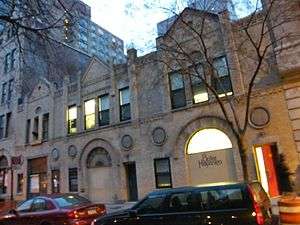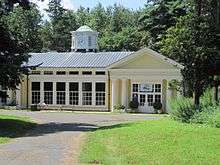Frank A. Rooke

Frank Aydelott Rooke, known professionally as Frank A. Rooke, was a New York City architect who established his practice in 1887, and pursued his career until the mid-1930s. He was long associated with the Sheffield Farms dairy company, for which he designed four pioneering pasteurization and bottling plants. He also designed stables and carriage houses.
Early career
Rooke was born in 1862 in Rye, New York,[1] and opened an office at 1262 Broadway in Manhattan in 1887.[2]:2 That year he designed a building combining a store, a stable, and apartments for Loton Horton of the Horton Ice Cream Co., at 371 Amsterdam Avenue, in the Upper West Side–Central Park West Historic District (designated by the New York City Landmarks Preservation Commission). In 1888 Rooke formed a partnership with architect Paul F. Riggs. They designed a Flemish/Romanesque Revival style apartment building in 1889–90 at 373–375 Amsterdam Avenue adjacent to Rooke's 1887 building, also commissioned by Horton.[3][4]:132–33
Higgs & Rooke designed a row of seven houses built in 1889 at 669–681 10th Street in what is now the Park Slope Historic District in Brooklyn,[5] and in Manhattan a pair of houses on West 92nd Street, a single house on West 77th Street, and a pair on West 147th Street, all built in 1890. In 1892 Rooke, again in private practice, designed the Claremont Stables, and adjacent private stables at 167, 169, and 171 West 89th Street.[3]
Sheffield Farms
%2C_detail_of_terracotta.jpg)
Rooke pioneered the design of large-scale milk plants, for the Sheffield Farms–Slawson–Decker Company (aka Sheffield Farms), which was established in 1902 with Loton Horton as its president and which was at the forefront of the dairy business in the early 20th century. In 1903 Rooke designed a stable and milk depot for the company, at the southwest corner of Broadway and 130th Street in Manhattan (now demolished).[6]:§8:3–4[2]
In 1907, Sheffield Farms erected its first pasteurization and bottling plant, at 524–528 West 57th Street, to Rooke's design. It was the first large-scale pasteurization plant, with the first continuous holding system of pasteurization, in the country. In 1909 Rooke designed a four-story addition to the 1903 stable, giving it an electric freight elevator and a new facade topped with a Mansard roof.[7]
In 1911 the company erected its second plant, also to Rooke's design. At 632 West 125th Street, the former plant stands today as Columbia University's Prentis Hall, home of the Computer Music Center. It features a glazed white terracotta façade, and the interior retains the original Guastavino tile vaulted ceiling.[6]:§8:5[8][7]
Rooke designed a third Sheffield Farms Milk Plant, which opened in 1914 at 1075 Webster Avenue at 166th Street in the Bronx (now demolished).[2] It was one of the most expensive and elaborate milk plants, with one of the largest processing capacities, in the country. The following year a company publication described Rooke as the "Company Architect".[2]:3 In 1917 Sheffield Farms completed another plant designed by Rooke, at 1368 Fulton Street in Brooklyn,[9] at Marcy Avenue, in the Bedford–Stuyvesant section; it was advertised as the largest in New York. Like the Bronx plant, it has a glazed terracotta facade ornamented with reliefs of milk bottles and cow heads. Sheffield closed this plant in the early 1960s, a time of civil unrest there with gang wars and riots, and the plant remained empty several years before a new non-profit, the Bedford–Stuyvesant Restoration Corporation, turned the plant into the Billie Holiday Theatre, which opened in 1972.[10]
Other work
In 1906 Rooke incorporated dairy-plant features, like enameled brick walls, into plans for two structures at a private residence in Rye, New York; he designed a Classical Revival Carriage House as well as a unique Zebra Barn for financier Warner M. Van Norden. Both buildings are extant and undergoing restoration at the Jay Heritage Center.[11][12]
In 1912 Rooke designed an alteration to the Mount Morris Bank Building in Harlem.[13][14] Rooke's last known commissions were an alteration to a four-story commercial building at 130 West 45th Street in 1934,[2]:3 and a 1934–36 alteration of the one-story 433 W. 127th Street to three stories for the Horton Pilsener Company.[15] Sheffield Farms replaced Rooke's 57th Street plant in 1937 with a massive new milk plant designed by a different architectural firm. [16][2]:3
Rooke died in 1946.[17]
References
| Wikimedia Commons has media related to Frank A. Rooke. |

- ↑ "Frank A. Rooke-designed house in Metuchen, New Jersey". H-Net. March 3, 2012. Retrieved April 17, 2016.
- 1 2 3 4 5 6 Perkins, L. Bradford; Campagna, Barbara A. (1991). "Sheffield Farms Milk Plant" (PDF). Library of Congress (PPOC) (Historic American Engineering Record report). Photographs by Richard D. Pieper (New York City). Retrieved April 17, 2016.
- 1 2 Marthey, Lynne (August 14, 1990). Pearson, Marjorie, ed. "Claremont Stables" (PDF). Neighborhood Preservation Center (New York City Landmarks Preservation Commission designation report). p. 5. Archived (PDF) from the original on March 10, 2016. Retrieved April 15, 2016.
- ↑ "Upper West Side/Central Park West Historic District Designation Report—Volume II: Building Entries" (PDF). NYC (Landmarks Preservation Commission). New York City. April 24, 1990. pp. 132–33. Retrieved April 17, 2016.
- ↑ "Park Slope Historic District Designation Report" (PDF) (Landmarks Preservation Commission report). City of NewYork. July 17, 1973. pp. 130–31. Retrieved April 17, 2016.
- 1 2 Coombs, Tamara (July 2005), "Sheffield Farms Stable" (PDF), New York State Cultural Resource Information System (CRIS) (National Register of Historic Places Registration Form), retrieved March 30, 2016; and accompanying 16 photographs
- 1 2 Habstritt, Mary (February 13, 2008). "Manhattanville and New York City's Milk Supply". Gray Wolf's Howl. New York: J. Reyes–Montblanc. The Manhattanville Connection, paragraphs 9–11. Archived from the original on November 14, 2013. Retrieved March 29, 2016.
- ↑ "Sheffield Farms–Slawson–Decker Company Co. Approved Milk Pasteurization Plant". Architecture and Building. New York: William T. Comstock Co. 43 (12): 529. September 1911. Retrieved March 26, 2016.
- ↑ "Creamery and Milk Plant News". The Creamery and Milk Plant Monthly. Chicago: National Milk Publishing Co. VI (4): 27. December 1917. Retrieved April 18, 2016.
- ↑ Spellen, Suzanne. "Past and Present: Fulton Street at Marcy Avenue". Brownstoner. Brooklyn, N. Y. Archived from the original on April 18, 2016. Retrieved April 18, 2016.
- ↑ "Zebra Testing Scheme". Amsterdam [NY] Evening Recorder. November 15, 1906. p. 3, paragraph 3. See newspaper page.
- ↑ Clary, Suzanne. "The Horse Show Bride and Groom". SohoNYC. Weston, Connecticut: Weston Magazine, Inc. (57): 151. Archived from the original on April 23, 2016. Retrieved April 23, 2016 – via issuu.
- ↑ Dolkart, Andrew Scott (January 5, 1993). Pearson, Marjorie, ed. "Mount Morris Bank Building" (PDF). Neighborhood Preservation Center (New York City Landmarks Preservation Commission designation report). New York City Landmarks Preservation Commission. p. 3. Archived (PDF) from the original on March 25, 2016. Retrieved April 21, 2016.
- ↑ ""Corn Exchange Bank"". New York Architecture. photo. Archived from the original on March 4, 2016. Retrieved April 21, 2016.
- ↑ "Yeungling Brewing Complex (6 Sites), Manhattan". Six to Celebrate. New York City: Historic Districts Council. Archived from the original on April 18, 2016. Retrieved April 18, 2016.
- ↑ That building was purchased by CBS in 1952 (see "Sheffield Plant Resold to C.B.S.", The New York Times, retrieved April 21, 2016), and today houses the CBS Broadcast Center.
- ↑ Grave marker at Kensico Cemetery, 273 Lakeview Ave, Valhalla, Westchester County, New York